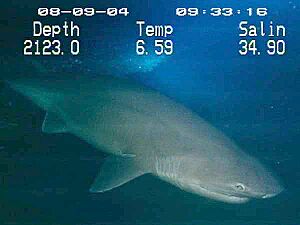Cow shark facts for kids
Quick facts for kids Cow sharks |
|
|---|---|
 |
|
| Scientific classification |
|
| Kingdom: | Animalia |
| Phylum: | Chordata |
| Class: | Chondrichthyes |
| Order: | Hexanchiformes |
| Family: | Hexanchidae J. E. Gray, 1851 |
| Genera | |
|
See text |
|
Cow sharks are a fascinating group of sharks known for their ancient features. They belong to a family called Hexanchidae. What makes them really special is that they have more gill slits than most other sharks. While most sharks have five gill slits, cow sharks have six or even seven! These unique sharks are like living fossils, showing us what some of the earliest sharks might have looked like.
Contents
What Makes Cow Sharks Special?
Cow sharks are often called the most "primitive" sharks. This means their bodies, especially their skeletons, look a lot like very old sharks that are now extinct. They haven't changed much over millions of years! Scientists think their internal systems, like how they process food, are also similar to ancient shark ancestors.
Their Unique Gills
The most noticeable thing about cow sharks is their extra gill slits. Most sharks have five gill slits on each side of their head, which they use to breathe underwater. But cow sharks have six, and some even have seven! This is very unusual and helps them stand out from other shark families.
How Big Are Cow Sharks?
These sharks can grow quite large. Adult cow sharks can be anywhere from about 1.4 meters (about 4.5 feet) to 5.5 meters (about 18 feet) long. That's longer than a small car!
What Do They Look Like?
Cow sharks have a body shape that's like a cylinder, a bit like a tube. Their mouth is on the underside of their head. Inside, they have very interesting teeth! Their lower jaw has flat, comb-like teeth, while their upper jaw has smaller, pointy teeth. They have only one dorsal fin (the fin on their back), which is short and doesn't have any spines. Their other fins, like the pectoral (side) and pelvic (bottom) fins, are also distinct. Their tail fin has a small dip or "notch" near the end.
Life Cycle and Diet
How Cow Sharks Reproduce
Cow sharks have a special way of having babies called ovoviviparity. This means the mother keeps the eggs inside her body. The baby sharks hatch from their eggs while still inside the mother, and then she gives birth to live, fully formed young. It's a bit like a mix between laying eggs and giving live birth!
What Do Cow Sharks Eat?
These sharks are skilled hunters. They eat many kinds of fish, including other sharks! They also enjoy crustaceans, like crabs and lobsters, and they aren't picky about eating carrion (animals that are already dead). This varied diet helps them survive in their deep-sea homes.
Cow Sharks Through Time
Ancient Shark Relatives
Scientists learn about ancient cow sharks mostly from their fossilized teeth. Finding complete skeletons of these sharks is very rare! Most skeletal fossils have been found in special rock formations from the Jurassic Period (a very long time ago, when dinosaurs roamed the Earth) in places like Germany and Lebanon. Because we don't find many full skeletons, some scientists believe that cow sharks might have been even more common and diverse in the past than we currently know.
Types of Cow Sharks
There are many different kinds of cow sharks, both alive today and extinct. Scientists have identified over 40 species of cow sharks throughout history! However, only five of these species are still swimming in our oceans today. These living species are grouped into three main types:
- The Sharpnose sevengill shark (Heptranchias perlo)
- The Bluntnose sixgill shark (Hexanchus griseus)
- The Bigeyed sixgill shark (Hexanchus nakamurai)
- The Atlantic sixgill shark (Hexanchus vitulus)
- The Broadnose sevengill shark (Notorynchus cepedianus)
These sharks live in deep waters around the world.
Images for kids


